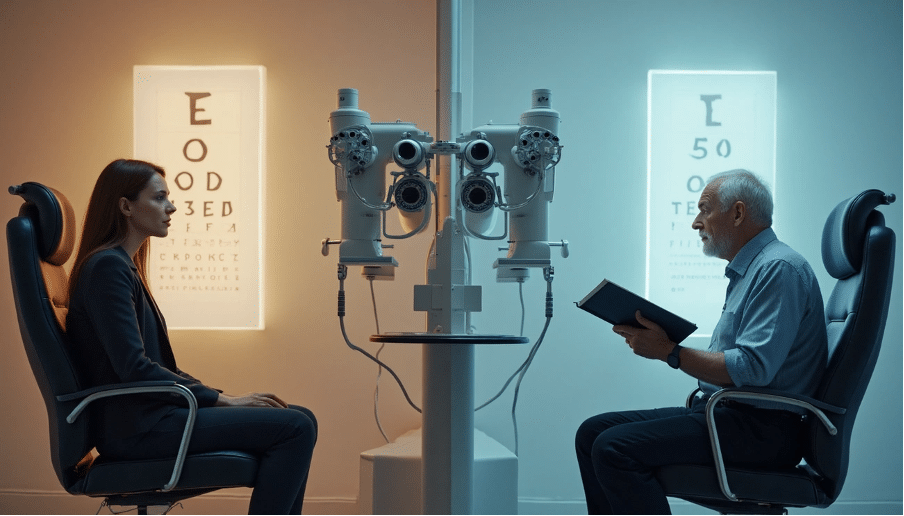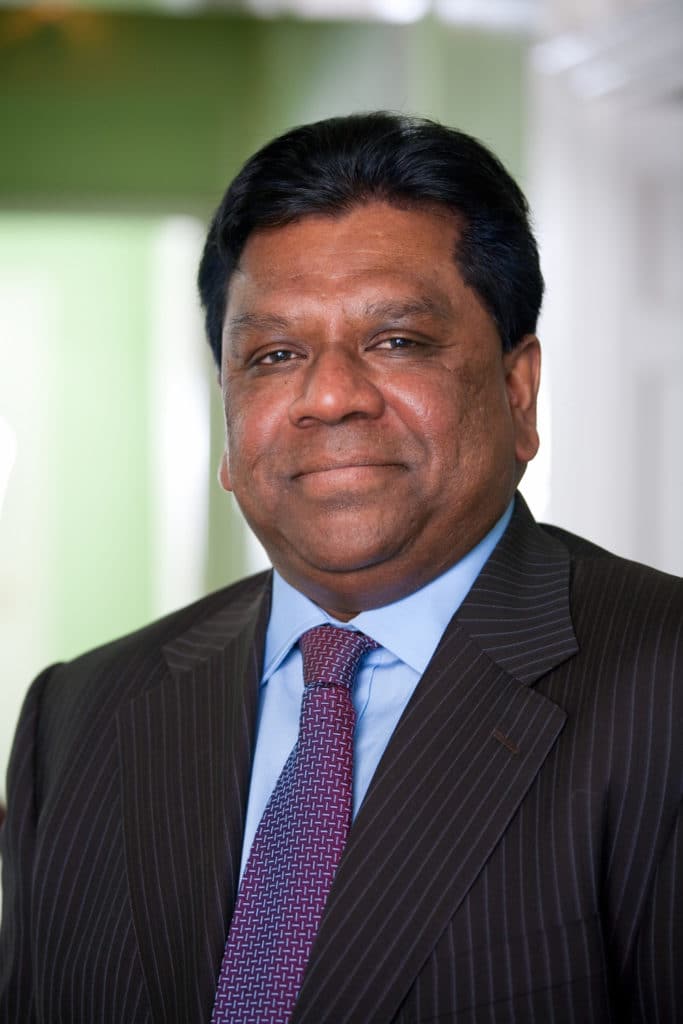Short-sightedness and long-sightedness are common vision problems among Britons. One in three UK adults deals with short-sightedness. People with myopia see distant objects as blurry, while those with hyperopia struggle to see things up close. This condition affects about one in four people. The World Health Organisation predicts that myopia could affect more than half of the world’s population by 2050. More indoor time and close-up work are the main reasons behind this trend.
The key to choosing the right vision correction lies in knowing the difference between myopia and hyperopia. These conditions come from refractive errors but need different treatment approaches. Modern treatments like laser and lens-based surgeries have shown great results. The success rate stands at over 98%, giving patients a reliable path to better vision.
Precision Vision London’s team helps you find the best vision correction option for your needs. Our expert team uses the latest technology to create the right treatment plan for your eyes. This becomes crucial if you spend long hours looking at screens or notice age-related vision changes. In this piece, you’ll find how the right diagnosis and treatment can reshape your vision and boost your life quality.

How Vision Problems Are Diagnosed at Our Clinic
Precision Vision London employs clinical expertise and advanced technology to identify vision problems accurately. A proper diagnosis is the foundation of successful vision correction, especially when we determine whether you have myopia or hyperopia. Our full picture will give you the most suitable treatment that matches your specific needs.
Original consultation and eye exams
Your visit starts with a detailed consultation that takes about 90 minutes. You’ll meet one of our consultant ophthalmologists who works in our private practise. This gives you the highest quality of care. We review your vision concerns, lifestyle needs, and medical history in detail during this first meeting.
The eye examination has these vital components:
- Visual acuity testing to measure how well you see at different distances
- Visual field assessment to review your peripheral vision
- Eye movement and alignment checks
- Pupillary reflex evaluation
- Intraocular pressure measurement to screen for conditions like glaucoma
Understanding your prescription and eye shape
Our specialists explain your prescription thoroughly after your examination. Your prescription shows if you have myopia (negative numbers) or hyperopia (positive numbers). To cite an instance, a prescription of -2.00 means you need two diopters of power to fix your nearsightedness.
Your prescription will show these additional measurements if you have astigmatism:
- Cylinder (CYL) – shows the lens power needed to correct astigmatism
- Axis – indicates where the irregular curve affecting your vision sits
We might create a detailed three-dimensional map of your eye’s surface using corneal topography in complex cases. This advanced imaging helps especially when fitting contact lenses and planning laser surgery procedures.
Identifying the type of refractive error
Our expert team determines how your eyes focus light through refraction assessment. You’ll look through various lenses while reading an eye chart. This helps us identify if you have:
- Myopia (nearsightedness) – objects far away appear blurry
- Hyperopia (farsightedness) – close objects become hard to focus on
- Astigmatism – blurred vision from an irregularly shaped cornea
Need help deciding between myopia and hyperopia? Get expert guidance and explore vision correction options at Precision Vision London. Book your eye exam today. The same consultant who performs your assessment will handle your treatment and follow-up consultations at Precision Vision London. This gives you personalised attention throughout your care.
Treatment for Myopia: Options and Innovations
Modern myopia treatments have made substantial progress over the last several years. You now have multiple ways to fix your vision and slow down its progression. Your options range from basic corrective lenses to advanced surgical procedures. Each option has its benefits based on your vision needs and lifestyle.
Corrective lenses for daily use
Glasses and contact lenses are still the most common way to treat myopia. They work well to fix blurry distance vision, but standard single-vision lenses don’t help stop myopia from getting worse. The good news is that special glasses like ZEISS MyoCare and Hoya MiYOSMART have tiny structures built in. These glasses don’t just correct vision – they can slow myopia progression by approximately 50%. These innovative lenses use small lenslets that create peripheral defocus. This helps control eye growth and keeps your central vision clear.
Laser eye surgery (LASIK, PRK, SMILE)
Laser vision correction gives you a lasting solution with impressive results. LASIK leads the pack as the most popular choice. It creates a corneal flap to reshape the tissue underneath, and you can see clearly within 1-2 days. PRK (Photorefractive Keratectomy) might suit you better if you have thin corneas, though recovery takes about a month.
SMILE (Small Incision Lenticule Extraction) shows how far we’ve come. It needs just a 3mm cut compared to LASIK’s 18-20mm opening. This approach keeps more corneal nerves intact, which means you might have fewer dry eye issues while still fixing your myopia effectively.
Implantable Contact Lenses (ICL)
ICLs are a great option if laser surgery isn’t right for you, especially when you have high prescriptions up to -18.00D. These soft, flexible lenses sit between your natural lens and iris. You don’t need daily maintenance, and doctors can remove or replace them if needed. This makes ICLs a reversible choice.
Refractive Lens Exchange (RLE)
RLE works similar to modern cataract surgery – doctors replace your natural lens with an intraocular lens (IOL). We recommend this mostly for patients over 50 or those with early cataracts. This procedure means you won’t need cataract surgery later. About 95% of patients can see well enough to drive or better after RLE.
Treating Hyperopia with Precision
Hyperopia correction needs a different approach than myopia treatment. The goal focuses on increasing your eye’s focusing power instead of reducing it. Precision Vision London tailors modern treatment options to match your specific degree of long-sightedness, eye anatomy, and lifestyle needs.
Laser correction for long-sightedness
Laser eye surgery fixes hyperopia by reshaping the cornea into a steeper curve. This allows light to focus on the retina correctly instead of behind it. LASIK surgery makes a thin flap in the cornea to reshape the underlying tissue. Most patients return to their normal activities within 24-48 hours. Patients with thinner corneas might benefit from PRK and LASEK procedures. These methods modify the corneal surface without creating a flap.
Laser correction shows impressive success rates for mild to moderate hyperopia. Most patients achieve vision that meets or exceeds driving standards. The procedure takes about 30 minutes for both eyes under local anaesthetic eye drops.
When lens-based solutions are better
Patients with higher degrees of hyperopia or those who can’t have laser surgery often get better results from lens-based treatments. Implantable Contact Lenses (ICLs) sit between your natural lens and iris. These soft, flexible implants need no daily care.
Refractive Lens Exchange (RLE) replaces your eye’s natural lens with an artificial intraocular lens (IOL). This option works best for:
- Those with significant hyperopia beyond laser surgery’s range
- Patients over 50 who might develop cataracts later
- People who want to fix both hyperopia and presbyopia at once
Addressing age-related vision changes
Our eyes’ near focusing ability naturally decreases as we reach our 40s. This condition, called presbyopia, makes reading harder for people who already have hyperopia. Nearly 80% of Americans have presbyopia by age 45. This requires special treatment approaches. RLE with multifocal lens implants can fix both hyperopia and presbyopia together. Monovision LASIK offers another solution by correcting one eye for distance and the other for near vision.
Modern presbyopia-correcting surgeries have advanced significantly. Specialised IOLs now give clear vision at multiple distances. This approach prevents future cataract surgery while fixing current vision problems.
Your Personalised Journey at Precision Vision London
Precision Vision London offers a personalised path to clearer vision. We know that fixing myopia and hyperopia takes more than just technical skills. Each patient just needs a customised experience that matches their unique needs and lifestyle.
What to expect during your consultation
Your consultation takes about 90 minutes to give us a complete picture of your eyes. You’ll meet one of our consultant ophthalmologists. They will ask about your vision concerns, medical history, and lifestyle requirements.
Our detailed eye exam has visual acuity testing, pressure measurements, and advanced diagnostic scans if needed. We’ll explain your prescription clearly and help you understand if you have myopia, hyperopia, or astigmatism. This helps you make informed decisions about your vision correction options. Not sure about myopia and hyperopia? Let our experts guide you through vision correction options at Precision Vision London. Book your eye exam today.
How we tailor treatments to your lifestyle
Every patient comes with unique needs, so we focus on personalised care. Your consultant becomes your partner from assessment through recovery. This ensures your treatment plan matches your vision requirements perfectly.
Your occupation, hobbies, and daily activities shape our recommendations. To name just one example, see how a long-haul driver who just needs better night vision might get different correction options than someone who does mostly close-up work.
Post-treatment care and follow-up
After your procedure, you’ll get clear aftercare instructions and continuous support. Most patients come back for follow-up appointments 4-6 weeks after surgery. Your recovery guidance covers:
- Using prescribed eye drops correctly
- Protecting your eyes from irritants
- Managing temporary side effects
- Gradually resuming normal activities
The same consultant handles your aftercare, giving you consistent care throughout your trip.
Why patients trust our expertise
Our dedicated ophthalmologists lead their fields. Patient comfort and satisfaction matter most to us. The core team brings both skill and compassion to their work. We take an integrated approach to your eye health. A complete eye exam can show early signs of other health conditions. Sometimes the best care means recommending no treatment at all, and we’ll always give you that honest advice.
Conclusion
Understanding Your Vision Correction Experience
This piece explores the key differences between myopia and hyperopia that affect millions of Britons every day. A clear understanding of these differences will help you take the first step toward better vision and independence.
Precision Vision London helps reshape your vision with state-of-the-art diagnostic technology and customised treatment plans. Our consultant ophthalmologists will guide you through all options available, whether you have trouble seeing distant objects due to myopia or find it hard to focus on close-up tasks because of hyperopia. Your vision’s unique needs deserve solutions that fit you perfectly. We think over your lifestyle, job, and priorities to recommend the right treatments—from innovative corrective lenses to advanced surgical options. Our 90-minute consultation will give a full picture of your eyes’ health before we suggest any next steps.
A life free from vision limits is possible. Many patients tell us they’re amazed by their improved quality of life after treatment. Clear vision when you wake up or enjoying outdoor activities without glasses become normal parts of your day instead of wishful thinking.
Start your path to visual freedom now. Reach out to Precision Vision London to get your complete eye assessment. Our customised approach, combined with state-of-the-art technology and expert care, can help you achieve the best possible vision. Your path to clearer sight starts with knowing your options and ends with seeing the world exactly as it should be seen.
FAQs
Q1. What percentage of the UK population is affected by myopia and hyperopia? Approximately one-third of UK adults have myopia (short-sightedness), while about one in four people are affected by hyperopia (long-sightedness). These common vision conditions impact a significant portion of the population, with myopia rates expected to increase in the coming years.
Q2. What is the typical cost range for LASIK eye surgery in the UK? The cost of LASIK eye surgery in the UK can vary depending on factors such as the type of procedure and the clinic. Standard LASIK typically ranges from £2,590 to £6,200 per eye, while more advanced procedures like bladeless LASIK may cost between £2,990 and £6,200 per eye.
Q3. How do corrective lenses address myopia and hyperopia? For myopia, lenses with negative refractive power are used to lengthen the focal point, allowing distant objects to be seen clearly. Hyperopia is corrected using lenses with positive refractive power, which bend light to focus properly on the retina, improving near vision.
Q4. Are laser eye surgery and lens replacement procedures available on the NHS? Generally, laser eye surgery and lens replacement procedures are not available on the NHS. These treatments are typically offered privately. However, in certain cases where an eye condition could lead to vision loss or when vision problems cannot be corrected with glasses or contact lenses, the NHS may consider providing laser eye surgery.
Q5. What innovative treatments are available for managing myopia progression in children? Several effective strategies are now available for controlling childhood myopia progression. These include low-dose atropine eye drops, which can slow progression by about 50%, and specialised contact lenses like orthokeratology and dual-focus designs that have shown to reduce progression by nearly 60% over three years. Additionally, increasing outdoor time and limiting screen time may help naturally moderate myopia development.
Authors & Reviewer
-
 Olivia: Author
Olivia: AuthorHi, I'm Olivia, a passionate writer specialising in eye care, vision health, and the latest advancements in optometry. I strive to craft informative and engaging articles that help readers make informed decisions about their eye health. With a keen eye for detail and a commitment to delivering accurate, research-backed content, I aim to educate and inspire through every piece I write.
-
 Dr. CT Pillai: Author
Dr. CT Pillai: AuthorDr. CT Pillai is a globally recognised ophthalmologist with over 30 years of experience, specialising in refractive surgery and general ophthalmology. Renowned for performing over 50,000 successful laser procedures.

